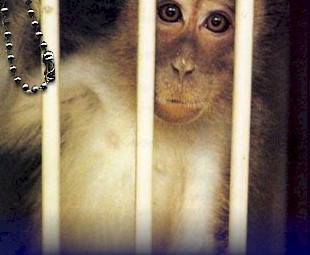






|
||||||||||||||||||||||||||||||||||||||||||||||||||||||||||||||||||||||||||||||||||||||||||||||||||||||||||||||||||||||||||||||||||||||||||||||||||||||||||||||||||||||||||||||||||||||||||||||||||||||||||||||||||||||||||||||||||||||||||||||||||||||||||||||||||||||||||||||||||||||||||||||||||||||||||||||||||||||||||||||||||||||||||||||||||||||||||||||||||||||||||
The Argument In the late 1950's researchers came back from a tour in the Soviet Union. While there, they visited the Soviet’s primate research facility. These scientists became alarmed that the Soviet Union was ahead of us in the biomedical race. Their trip seems have led to James Watt, director of the National Institutes of Health, testifing before Congress about the need for a similar program in the United States if we were not to be left behind. At that time, nearly 45 years ago, our understanding of primates
was very limited and naive. Philosophers and ethicists of the time
believed that the gulf between humans and other animals was wide
and clearly defined: Only humans made, modified, and used tools.
Only humans possessed language. Only humans possessed culture. Only
humans participated in systematic warfare. Only humans could exhibit
altruistic behavior. Only humans pondered death and participated
in religious ritual. Monkeys and apes, while they might be something
like us in appearance and biology were nothing like us inside, in
heart and mind. Today we know that those philosophers and ethicists were completely
wrong. Tool use in primates was first discovered in 1960 by Jane Goodall
. Since that time we have learned that chimpanzees use an assortment
of tools. Examples of meta-tool use, using a tool to modify or improve
another tool, have been documented. Capuchins, a new world species
of monkey, are known tools users as well; and macaques, an old world
group, readily learn to operate computer joysticks in laboratories.
Almost 30 years ago people began to search for ways to communicate
with apes and monkeys. They wondered whether real language use was
even possible for non-humans. Today, many chimpanzees have been
taught American Sign Language and have been engaging in dialog with
humans. From these conversations it is now clear that their perceptions
of the world are nearly identical to ours. They combine words to
coin new expressions for novel situations and objects which we fully
understand. An example of this is a chimpanzee signing, fruit drink
when inventing a name for Kool Aid. Chimpanzees, bonobos, orangutans,
and gorillas have all been found to be adept at learning human language.
To date, few humans have come close to learning a non-human primate
language. Noam Chompsky once criticized the research in sign language
saying that if chimpanzees were capable of a gestural language they
would be using one in the wild. He believed that this put the matter
to rest, but since then we have learned that chimpanzees do use
such a language in the wild. The discovery that chimpanzees use a gestural language in the wild
has contributed to the understanding that culture is passed from
generation to generation. Language and tool use are both used in unique ways between different
chimpanzee groups. The knowledge of how to use a specific tool and
specific gestures is learned and transmitted between generations.
Rhesus macaques use at least 18 different words or phrases (calls)
in the wild, but when raised in captivity, a culturally deprived
setting, they learn only five or six. It has been known for eons that animals will sometimes fight with
each other, but systematic warfare was considered a uniquely human
trait. It is now known that chimpanzees sometimes engage in long
term aggression with neighboring groups and will systematically
murder each member of the "enemy" group. This is accomplished
through a band of mostly males silently searching for isolated members
of the rival community and killing them. Such campaigns can last
months on end with frequently repeated excursions into the rivals’
territory. Altruism has long been a bastion of human uniqueness, but the frequency
of adoption of orphaned babies in chimpanzee society is high. Chimpanzees
are well known for their willingness to put themselves at risk to
aid a friend. Gorillas will defend their group members to the death.
People observing chimpanzees in the wild have been given food by
them. And who did not read of the child saved at the Brookfield
Zoo in Chicago by Binti Jua , the captive lowland gorilla? During a particularly violent lightning storm, Jane Goodall observed
a group of chimpanzees repeatedly run down a hill one at a time
brandishing a branch. After running down the hill screaming and
waving the branch each chimpanzee would climb back up to repeat
the performance. The group continued this ritual until the electrical
storm had passed. Had an anthropologist observed the same phenomena
while studying a tribe of humans she would have likely believed
it to be a religious rite. When asked what happens to you when you die, a gorilla answered
in sign, "Dark. Ground." Today, in biomedical laboratories around the world, monkeys and
apes are treated as if the past years of study mean nothing. The
ethical and moral implications of what we now know about the similarities
between human and non-human primates are ignored and suppressed
by the National Institutes of Health and the primate labs themselves.
Miles Novy " . . . studies . . . unanesthetized chronically
catheterized maternal-fetal preparations . . . ". He wants
to know how hormone levels change during pregnancy in rhesus macaques
and baboons. (Project number: 5 R37 HDO6159 -25). Virginia M. Gunderson has recieved a Scientist Development Award
to " . . . gain expertise. . . [and], . . . acquire the skills
to attain her career goals." She is injecting chemicals into
the brains of very young pigtailed macaques to try to induce seizures.
Alyssa Rulf Fountain, studying self-injurious behavior (SIB) such
as self-biting, reports that, ". . . the causes are largely
unknown." ( PN # 5 P51 RR00168 -36). Both of these studies above are ongoing, but as early as 1990 researchers
had found that even a small hole between cages of individually caged
monkeys which allowed them to touch each other stopped most of this
behavior. Ms. Fountain’s assertion notwithstanding, the cause
of SIB has been well known for years: Most non-human primates are
more social than humans and isolating them causes insanity. (See
D. Blum, The Monkey Wars, pg. 191). In a similar study at the Wisconsin center, researchers are scarring
the amygdala (a deep brain structure) of female monkeys to induce
a permanent state of fear. They want to know whether such stress
can affect a baby born to such an afflicted mother. Tulane Regional Primate Research Center: Margaret R. Clark is working
to enlarge the breeding colony of rhesus macaques. She wishes the
facility to produce an additional 150 babies a year. She says, "
. . . infants will be removed [from their mothers and all adult
monkeys] within three days of birth . . . Management practices will
maximize the psychological well-being of the animals." ( PN
# 5 P51 RR00164 -34, $103,241). Gamal M. Ghoniem is implanting vascular cuffs around the neck of
the bladder of rhesus macaques. A lead to this cuff runs out of
the monkeys’ bodies and allows him to squeeze off the neck
of the bladder while the monkeys attempt to urinate. He has found
that monkeys whose bladder necks are most tightly closed take longer
to pee than those with less obstruction. ( PN # 5 P51 RR00164 -36).
Opendra Narayan has successfully developed a cross between SIV
and HIV-1. He reports that this new virus he has created is, "highly
pathogenic in pigtailed macaques." He does not mention whether
it would be harmful to humans. ( PN # 5 P51 RR00165 -37). Margarete Tigges is sewing the eyelids shut on newborn infants.
( PN # 5 P51 RR00165 -37). William Gilbert is ligating (tying shut) esophagi and catheterizing
the tracheas of fetus rhesus macaques. He characterizes this as
chronic catheterization which means that these babies inside their
mothers have these tubes in them for days or months on end. ( PN
# 5 RR000169 -36). What these examples teach is that the federally funded primate
research centers around the United States have little regard for
or understanding of the animals they experiment on. Any abuse is
allowed in the name of Science. Studies routinely repeat experiments
that have been done on humans. Monkeys are disposed of as if they
are broken equipment. Every center has received warnings about the condition of the animals’
housing. Every center keeps monkeys in isolation. Every center receives
over 10 million dollars a year. Expansion is underway around the
country. Every law to protect and enhance the life of these animals
has been heavily lobbied against by the biomedical community. The researchers say this work is important because we learn about
humans since monkeys and apes are so like us, but at the same time
they say we should not be concerned over the torment these animals
suffer because they are so unlike us. Biomedical researchers have made the same arguments and done similar
things to minorities throughout history. The research taking place
at the NIH Regional Primate Research Centers is just more of the
same. Its root cause is the bigotry that is always associated with
unbridled hubris. Only when people speak out will it end. Rick Bogle 1997
Home Page | Our Mission | News |